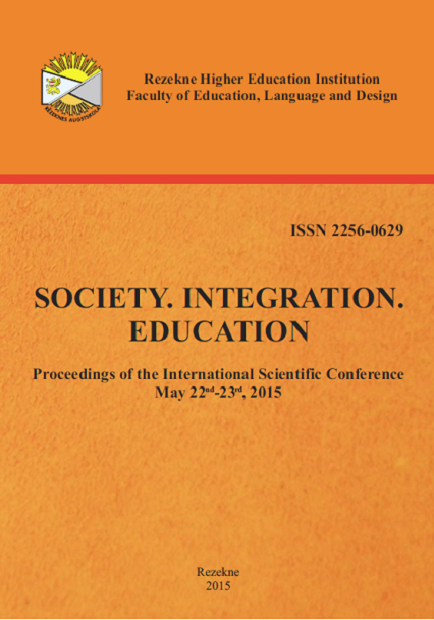The Connection between Young Students' Physical Health and Their Lifestyle
DOI:
https://doi.org/10.17770/sie2015vol3.468Keywords:
lifestyle, physical health, studentsAbstract
The goal of this research is to analyze the status of young students’ physical health and its connection with lifestyle. The research participants were 107 Medical College’s 1st year students that formed part of the youth category as it is defined in Latvia, i.e., up until the age of 25. Students’ physical health was evaluated in accordance with Apanasenko’s methods based on investigative anthropometric and functional testing measurements. These measurements included body mass index, vital capacity, strength index, Robinson index and Recovery Heart Rate. Students’ lifestyle habits were determined with the help of questionnaire that included question groups regarding the self-evaluation of health status, health problems and illnesses, eating habits, bad habits, rest and physical activities. During the research, lipid parameters in blood were also measured determining the total cholesterol (TC), high-density lipoprotein (HDL) and low-density lipoprotein (LDL).
References
Bohannon, R.W. (2008). Hand–grip dynamomometry predicts future outcomes in aging adults. Journal of Geriatric Physical Therapy, 31 (3), (3–10).
Boutayeb, A. (2006). The double burden of communicable and noncommunicable diseases in developing countries. Transactions of the Royal Society of Tropical Medicine and Hygiene, vol. 100, no. 3, pp 191–199.
Craig, C.L. et al. (2003). International Physical Activity Questionnaire: 12-Country Reliability and Validity. Medicine & Science in Sports & Exercise. American College of Sports Medicine. DOI: 10.1249/01.MSS.0000078924.61453.FB
Jauja, J., Žilinska, A. (2003). Laboratorijas darbi fiziloģijā. Daugavpils: DU izdevniecība „Saule”
Jaunatnes likums: LR likums (2008). Latvijas Vēstnesis, 82 (3866), 28.05.2008.
Kapysheva, U.N., Makashev, E.K., Bakhtiyarova, S.K. (2013). Express Assessment of Population Health in Environmentally Unfriendly Region of Kazakhstan. European Researcher, Vol. 45, No 4, pp. 751–755.
Kaupužs, A., Lāriņš V. (2009). Starptautiskās aptaujas par fizisko aktivitāti (IPAQ) pilotpētījums kultūrvides adaptācijai Latvijā. LSPA Zinātniskie raksti, 21.-28. lpp.
Latvijas veselības aprūpes statististikas gadagrāmata. (2013). Slimību profilakses un kontroles centrs. http://www.spkc.gov.lv/veselibas-aprupes-statistika/
Matisāne, L., Romanovska, G. (2013). Veselības izglītība vispārējā vidējā un profesionālajā izglītībā. Metodiskais materiāls. Rīga: VISC. Elektroniskais izdevums. Lejuplādēts no http://visc.gov.lv/vispizglitiba/saturs/dokumenti/metmat/veselibas_izglitiba_vispvid_un_profizgl.pdf
Mintāle, I. (2014). Veselīgs uzturs kardiologa skatījumā. Latvijas Ārsts, Nr. 10, 63–66 lpp.
Noncommunicable diseases (2015). World Health Organization. Downloaded from http://www.who.int/mediacentre/factsheets/fs355/en/
Pampel, F.C., Rogers R.G. (2004). Socioeconomic Status, Smoking, and Health: A Test of Competing Theories of Cumulative Advantage, Journal of Health and Social Behavior, vol 45 (September), pp 306–321.
Risch, J., Papoy, A. (2005). The relationship between socioeconomic status and healthy behaviors: A mediational analysis, Hanover College. Downloaded from: http://psych.hanover.edu/research/Thesis05/PapoyRisch.pdf
Rubana, I.M. (2010). Uzturs fiziskā slodzē. Rīga: Izdevniecība RaKa.
Sabiedrības veselības pamatnostādnes 2014.–2020.gadam. (2014). Ministru kabineta 2014.gada 14. oktobra rīkojums Nr. 589. Lejuplādēts no http://polsis.mk.gov.lv/view.do?id=4965
Third Report of the National Cholesterol Education Program. (NCEP). Expert Panel on Detection, Evaluation and Treatment of High Blood Cholesterol in Adults (Adult Treatment Panel III). Final Report 2002 Circulation. 106 (25), 3143-3421.
World Health Organization (2000). Obesity: Preventing and managing the global epidemic. Report on a WHO Consultation on Obesity. Technical Report Series 894. Downloaded from www.who.int/nutrition/publications/obesity/WHO_TRS_894/en/
Клочко, М. Х. (2012). Оценка здоровья студента. Харьков: ХНАГХ
Михалюк, Е. Л., Малахова, С. Н., Левченко, Л. И. (2012). Анализ состояния здоровя студентов вузов города Запорожя. Слов ожанськие наукова–спортивние вiсник. Запорожье: Запорожский государственнûй медицинский университет, №5 (1).






